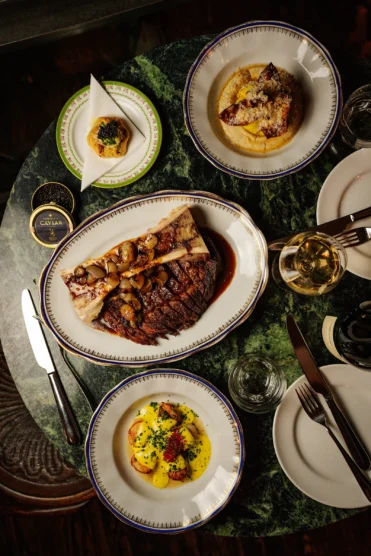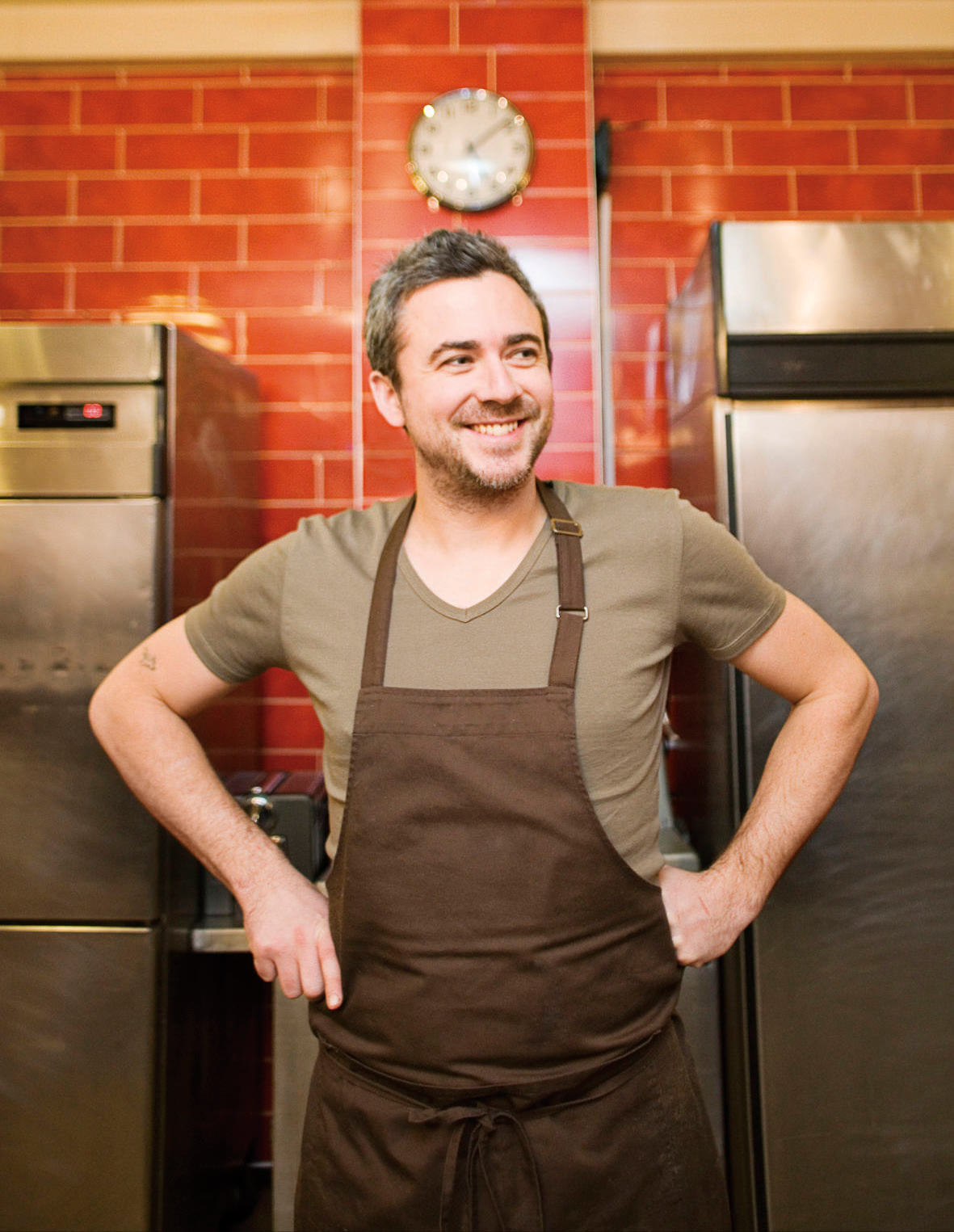Chef Grant van Gameren Goes Behind the Scenes at His Latest Restaurant Opening
If Martine's Wine Bar is the celebrated chef’s final act, then it deserves a standing ovation.

Grant van Gameren doesn’t like being called Gus. The chef behind some of Toronto’s most enduring culinary touchpoints—including Bar Isabel, Bar Raval, and the Michelin-starred Quetzal—makes that plenty clear in December 2024, when he reshares and mocks articles and Instagram stories from a popular Toronto food publication that repeatedly refer to him as such. It’s an outspoken blip on the otherwise sagacious path he has been following lately. And on the rare occasions when he does break his silence, it’s most often to maintain his well-deserved sense of peace. “I’ve been saying no, and I’ve been enjoying it,” he says.
Over the past few years, the chameleonic chef has stepped away from the limelight of Toronto’s culinary world, trading in his toque for a trowel at van Stone Farms, which he operates along with his wife, Sunny Stone, in Prince Edward County, where they reside with their two children. They made the move permanently in 2020, after COVID forced van Gameren to temporarily shutter his restaurants, which resulted in several legal battles with landlords and fees that forced them to sell their Toronto home.
While the move may have been distressing at the time, in the end it proved transformative for van Gameren, who has been able to focus on his family and nonculinary passion projects. “I’ve never really had hobbies,” he says. “My hobbies were always just opening restaurants. And so I’m trying to have some hobbies and be a normal person, because I can tell you, to be successful in the restaurant business, you’re far from a normal life or being a normal person.”
While his first kitchen experience came at a Pizza Pizza when he was just 15, and he later worked at some of the country’s most hallowed restaurants, including Canoe, it was 2008, when van Gameren opened the critically acclaimed nose-to-tail restaurant The Black Hoof alongside Jen Agg, that he began opening hit-making restaurants with near-tireless zeal. Bar Isabel, the still-popular Spanish-inspired restaurant on College Street, arrived in 2013. Bar Raval, another Spanish-inspired tapas spot, known for its stunning, room-encompassing, carved-mahogany accents, debuted in 2015. Quetzal, the one-Michelin-star Mexican joint that cooks entirely over open fire, arrived on the scene in 2018.


Understandably, these, along with other openings—including the now-shuttered eastern European comfort-food-focused Tennessee Tavern and Kensington Market’s buzzy El Rey Mezcal Bar—took a toll on van Gameren, so when coupled with the myriad stressors of being a restaurateur during COVID, a well-deserved break was in order. However, you can’t teach an old dog new tricks, and while van Gameren is just 43, in terms of restaurant experience he may as well be a centenarian.
___
“I get the itch every other day,” he says of the new restaurant concepts in his head that are begging to be brought to life.
The latest, Martine’s Wine Bar, which opened to rave reviews this past summer, shows that, hobbies be damned, van Gameren still has plenty to prove on Toronto’s ultracompetitive culinary scene.
Located at the rear of Bar Raval’s College Street address, the Palmerston Avenue space has been home to a slew of restaurants in recent years—including the much-loved Woodlot and an outpost of Harry’s Charbroiled, van Gameren’s burger chainlet—but it required a serious overhaul to achieve the moody, candlelit, wood-clad interiors that welcome diners today. Upon entry, the open kitchen and its impressive wood-fired oven peek through a brass shelving system that doubles as cellar overflow and is burdened with innumerable wine bottles, framing the inner workings of the restaurant for diners able to snag one of the few bar seats. Opposite, the slightly sunken bar dips down a few steps to make room for the mezzanine, where most of the restaurant’s seating is located. There, van Gameren’s personal quirks shine through, with some of the decor—including but not limited to oil paintings—expropriated straight from his house, to his wife’s chagrin.
Delegating the cooking to head chef Luke Haines (who forms part of the core Martine’s team alongside sommelier Hannah Holmes and co-owner/cocktail programmer Hailey Burke, also a partner at Bar Raval), van Gameren plays the role of sounding board and editor in the kitchen, helping refine dishes through his industry savvy and intimate knowledge of the available produce, most of which comes from van Stone Farms. The menu is typical of van Gameren’s restaurants, cohering around a cuisine or style but not restricted by dogmatism. In this case, the concept is that of a pan-European bistro, and the food draws inspiration from many different cultures, letting the produce take the fore.

Dishes like the carrots topped with tahini crème fraîche and mojo-rojo (a Canarian red sauce) and wood-oven-cooked Wakefield cabbage served over potato espuma and sprinkled with dill prominently feature produce and the work it takes to farm it while also showcasing van Gameren and Haines’s inimitable tandem prowess in the kitchen. On the other hand, the scrigno, filled with a near-feathery beef cheek ragu and served over a sunchoke béchamel, is a display of finesse that can almost knock diners backward into one of Stone’s oil paintings upon first bite.
But the marquee on the menu, as more than one server reassures me, is the chicken and fries. Slowly cooked in the wood-fired oven and rubbed with a peri-peri-esque blend of spices that hint at van Gameren’s fondness for Iberian cuisine, it’s a dish that may look simple but whose perfection has taken since at least 2008.
“Martine’s may very well be my last,” van Gameren says, as a hint of wistfulness peeks through on his self-confidently blasé visage. “I’m exhausted out of all these ideas, and old and tired. To a certain extent, I feel like I’ve given everything I can to Toronto.” And while his track record of success casts some doubt on that statement, if Martine’s is indeed the last stroke of van Gameren’s Toronto restaurant career, then it is masterful one. With it, he has taken a step back from the pulpit and let his talented team do the talking with their cooking and the atmosphere they cultivate. But the message, highlighting local ingredients, classic cookery, and most of all, fun, remains van Gamerenian to the core, resounding in the food regardless of his relative silence.
In the meantime, diners looking for some of the hushed chef’s characteristically candid takes can follow him on Instagram. The name on his profile? As of this writing, it’s Gus van Gameren.
Photographs by Daniel Neuhaus. All photographs courtesy of Grant van Gameren.




